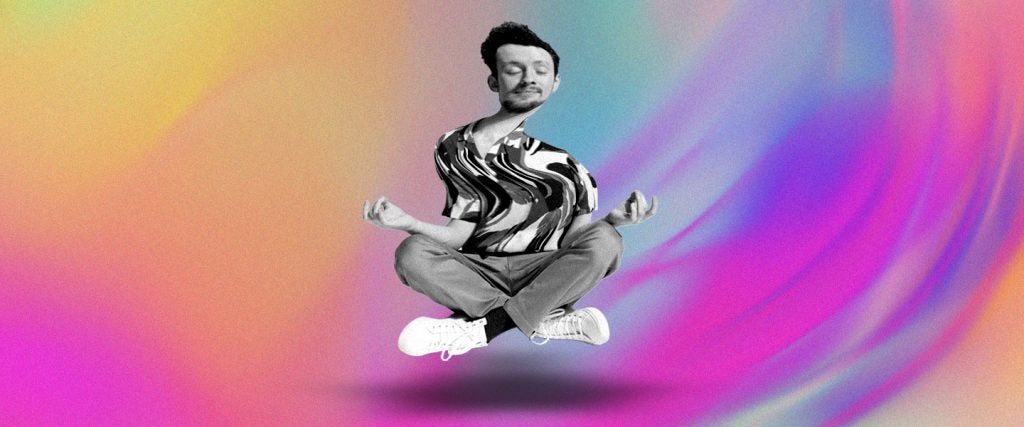There are numerous benefits to psychedelic trips, including, but not limited to, the following: They’re fun (and pretty safe); they can lead you to some big life realizations; they can help shitty situations become more bearable (or illuminate how you can escape them); and they can even potentially cure your depression. However, there are also a handful of downsides. For example, there’s a chance you might have a bad trip and not be able to get out of it; they typically last several hours (which, to be fair, can be good or inconvenient); and, in order to trip in the first place, you need to buy psychedelics, which you might find difficult to get hold of. Furthermore, although more people are said to be taking psychedelics — particularly microdosing them — many are still reluctant, scared or uninterested in trying them. But that doesn’t mean they don’t want to undergo a trip-like experience.
Luckily for those hankering for a drug-free psychedelic trip, there’s an app for that — as well as a breathing technique, and various tanks, chambers or “sensory reality” pods. But how similar to the real thing can these experiences actually be? And, more importantly, are these methods just a way for savvy companies to profit off a legal version of an en vogue trend?
For 22-year-old Alexandre, a computer science student from France, drug-free psychedelic trips offer him the chance to have an “amazing” experience without any dangers. “Psychedelics can fuck you up pretty hard if you’re not cautious enough,” he tells me. “[When I’ve taken them], I always try to be extra careful about it. So, if you say I can have a psychedelic-like experience without the risk — and the potential legal repercussions — of actual drugs, you have my attention.”
To achieve this feat, Alexandre uses the Lumenate app, which, according to Forbes, guides the user into an “altered state of consciousness between deep meditation and classic psychedelics” via light sequences on a smartphone’s flashlight. “At first, I was really hesitant,” says Alexandre, explaining that he didn’t think it would work. But soon, he was “mind-blown by how strong the experience can be.” Armed with his phone and a pair of headphones, he followed the app’s instructions and found a seat in a dark place. He then set the flashlight up in front of his face, and closed his eyes. The process — in which music plays and the light flashes — takes between five and 15 minutes, though Alexandre says 10 minutes was the “optimal” time for him.
“It’s mainly visual,” he explains. “At first, you’ll see shapes or different colors — mainly red and white for me — appearing in front of you. But after some time, the music intensifies, and you see a huge geometrical fractal forming in front of you. It can really feel like you’re in this immense room full of geometric figures.” The experience also put him in a similar headspace to the one he was used to experiencing with psychedelics, only noticeably less strong. “You feel your mind expanding in the environment,” he continues. “You can also feel a bit more emotionally naked. It’s pretty impressive.” After it ends, Alexandre sometimes experiences something akin to a psychedelic afterglow in which he feels “more relaxed and detached.” But it doesn’t last long — only about 10 minutes, in fact.
Alexandre discovered Lumenate during France’s spring lockdown last year — not long after it launched in March 2021. The app was founded by Bristol-based friends Tom Galea and Jay Conlon, whose aim was to inspire change in people’s lives through subconscious exploration. As reported by Forbes, “when light is flashed in a specific way, it causes the neurons in the brain to react and fire in a synchronized rhythm that safely guides the brain into a deeply meditative, semi-psychedelic state of consciousness.” Conlon told the publication that the result of this is “an instant and effortless way to explore your subconscious.”
When he first downloaded it, Alexandre was using Lumenate several times a day — sometimes by itself, and sometimes after he’d smoked. “With weed, it starts to get a bit more interesting,” he tells me. “The ‘headspace’ and the whole psychedelic feeling feels much stronger, and can have some kind of dissociative aspect to it.” However, he soon found that it lost its “magic and the ‘wow’ factor that came with it.” Now, he uses it sparingly, just to get a bit of “fresh air” into his mind.
Of course, this isn’t new technology — artist Brion Gysin, scientist Ian Sommerville and writer William Burroughs developed a device called the Dreamachine in the early 1960s, which was a revolving cylinder with holes in the outside and a lightbulb inside. When someone sat in front of the device with their eyes closed, the flickering lights were supposed to induce vivid illusions and a trance-like feeling. Although Gysin’s aim of the Dreamachine replacing TVs never came true, the device is set to be revived (and updated) by art producer Jennifer Crook this year, who suggests it will offer its visitors “transcendental experiences.”
Flashing lights aren’t the only way to induce a drug-free psychedelic trip, though. Later this month, shoppers in the U.K. will be able to head down to their local Selfridges department store to go on a “journey of uplifting self-discovery and nurturing self-care.” Once in store, participants will enter “sensory reality” pods created by Amsterdam-based startup Sensiks. Per the company’s website, the pods are designed to enable “a range of real-life and fantasy-based experiences in exquisite detail, with the body’s five senses stimulated simultaneously.” Via programmable actuators for heat, wind, airflow, tremble, light and sound effects, the pods can allegedly “conjure ‘out-of-body’ experiences that induce euphoria,” as well as improve a person’s quality of life, reduce stress and “relive and process memories from the past.” Outside of their Selfridges debut, the pods are available in certain clinical health settings (for the research and treatment of PTSD, anxiety or addiction), care homes, innovation centers, office spaces and airports.
Fred Galstaun, the director of Sensiks, says the idea for the pods came from his fascination with “the idea that we’re living in a dreamworld created by a collective mind or energy.” “Experiences are formed inside the brain, which responds to sensory inputs, creating interactions between objective experiences and subjective perceptions — memories, emotions and feelings — which eventually create the ‘real’ experience,” he explains. “The funny thing is that during a dream, those subjective experiences also feel very real. So somehow the brain has the capacity to experience worlds as real without needing the ‘real’ world for it.” Galstaun says he’s “somewhat obsessed” by the idea that we don’t need “the actual world to undergo profound experiences,” which has fed into his drive to create sensory reality experiences to “explore and optimize the power of the human mind or consciousness.”
However, although sensory reality technologies can create realistic representations of psychedelic experiences, he acknowledges that it would still be hard to simulate the effects and impact of an actual psychedelic trip. “The hallucinations, as well as the ’messages,’ are very personal, spontaneous, [unique] and cannot be designed upfront,” he says. Having said that, Galstaun suggests that those who use the pods can still have very impactful experiences.
For those who want a drug and technology-free experience — and don’t want to trip at Selfridges — many people swear by certain breathing techniques to induce a sort of psychedelic state. The most popular appears to be holotropic breathwork, which was developed as a therapeutic tool by psychiatrists Stanislav and Christina Grof in the 1970s, as a way of achieving an altered state of consciousness without drugs. (It was also created in response to LSD being made illegal in the late 1960s, as the Grofs were big proponents of acid’s therapeutic potential.) According to the Grof Transpersonal Training website, the technique combines “accelerated breathing with evocative music in a special set and setting.” Those practicing holotropic breathwork will lie down with their eyes closed, and use their own breath to “enter a non-ordinary state of consciousness,” which allegedly “activates the natural inner healing process of the individual’s psyche, bringing the seeker a particular set of internal experiences.”
Redditor Blech22222 said that his first time trying holotropic breathwork was pretty positive. “I did actually enter quite a dreamlike state from all the breathing,” he wrote on an r/Drugs thread. “But I also fell asleep shortly afterwards, so they were almost kind of like those hallucinations you have before falling asleep, except far more vivid, enhanced and highly emotional. I felt a deep tinge of contentment in them.” In another Reddit post, user travelingmaestro suggested that “it takes time to get into the zone” when practicing breathwork, at least 25 minutes for them. “I’m not sure what’s happening physiologically at that point, but, for me, it’s as if the body gradually settles into that slightly altered state as time passes and the breathing persists,” they say. They also note that holotropic breathwork can cause “group hallucinations” when done with others, and can make your body “feel like one continuous vibration.”
While these techniques might not work for everyone — or mirror the strength and impact of real psychedelics — they at least offer an interesting insight into the powerful possibilities of our psyches. Or, as Galstaun more eloquently puts it: “The power of our brain and senses is enormous, and the world has only just started to rediscover what it’s capable of.”

